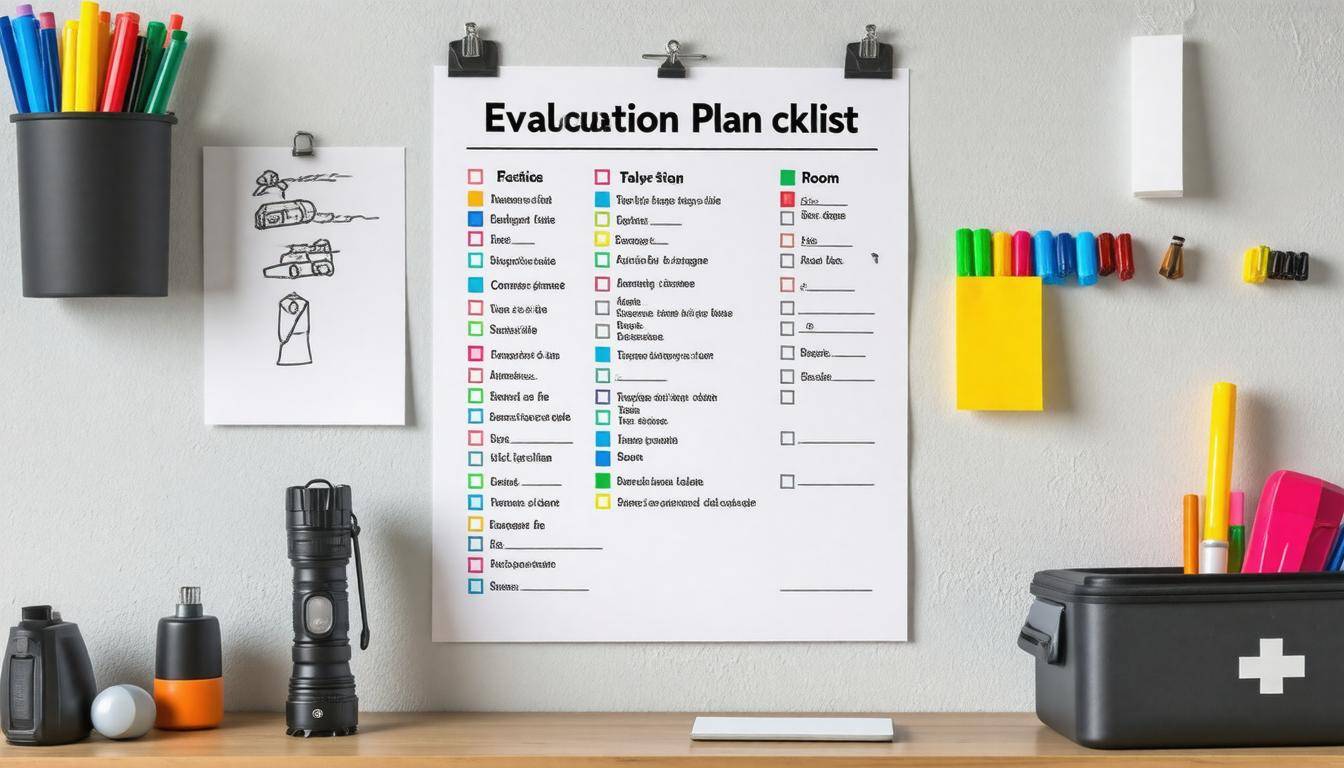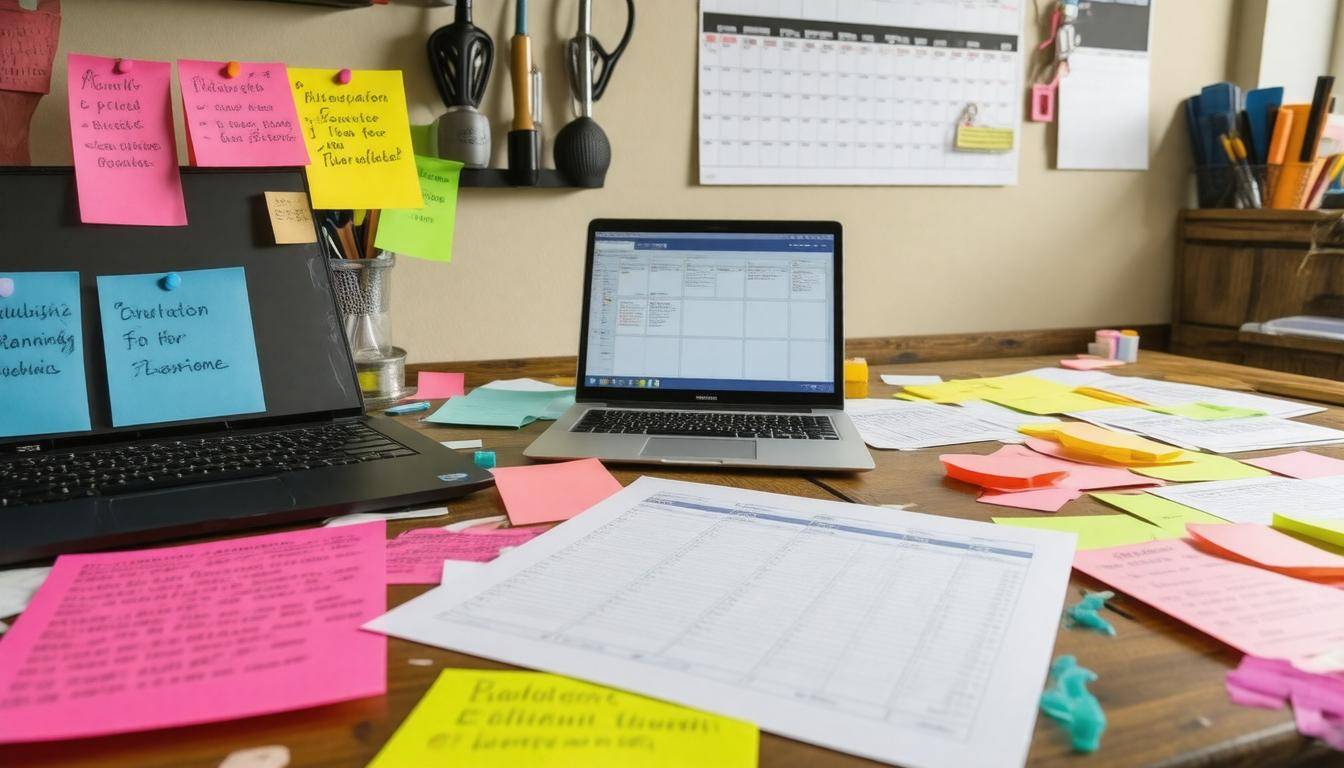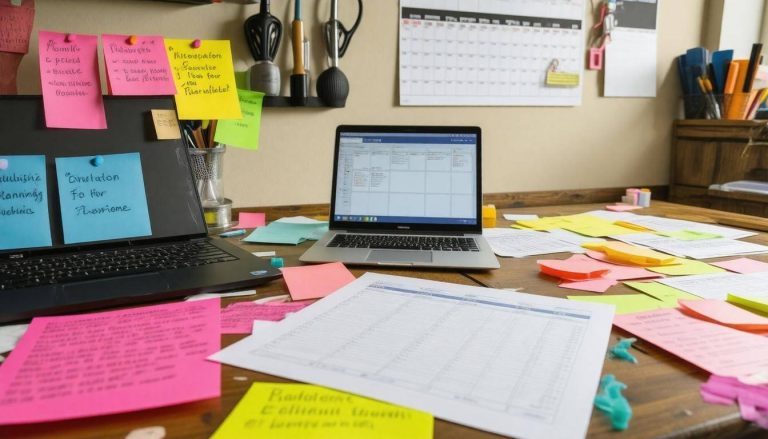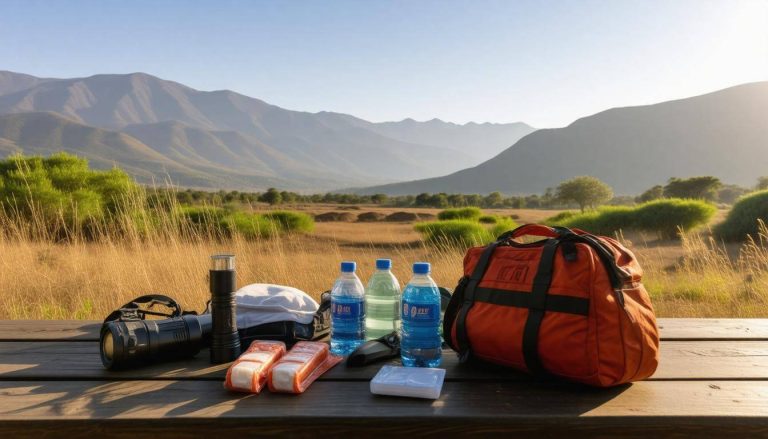When emergency situations arise, the chaos that follows can quickly turn overwhelming. Have you ever tried to gather your essentials in a hurry, only to find yourself frozen by confusion? Creating a 15-minute evacuation plan helps eliminate that feeling of panic and keeps everyone focused on getting to safety. In this guide, we’ll lay out a room-by-room checklist that covers everything from must-have documents to personal items. Whether you’re preparing for a natural disaster or unexpected emergencies, being ready can make all the difference. Together, we’ll ensure you and your family are well-equipped to handle whatever comes your way—so let’s dive into how to make an efficient escape plan!
A 15-minute evacuation plan room-by-room checklist should include essential items to gather, such as medications, important documents, personal identification, emergency supplies, and necessary first aid kits. Additionally, identify exits and safe meeting locations while ensuring clear communication roles among family members to facilitate a smooth evacuation process.

Front Door Essentials
The front door represents more than just an entrance; it’s your primary escape route during emergencies, making it essential to keep it in optimal condition. A clear path to your front door can be the difference between a quick exit and a dangerous delay. This means maintaining accessibility by routinely checking for obstructions. Besides the obvious shoes and bags that might get tossed around during a rush, consider looking down for small items like pet toys or decorative elements that could easily trip someone if they need to dash out quickly.
You also want to pay attention to the functionality of the door itself. Regularly testing the lock and hinges ensures they function without sticking or jamming, as even a slightly faulty mechanism can create panic during a critical moment. Doors should open swiftly with minimal effort; practice using it so that you become familiar with how it operates. In moments of stress, you’ll want to follow muscle memory rather than fumbling for keys or struggling against a stubborn handle.
Check Door Accessibility
Research indicates that over 60% of delays in evacuations stem from inadequate preparation at exit points. If family members know where to go immediately, this minimizes confusion and saves precious seconds. Take this time to embrace your inner organizer: a monthly inspection to ensure that everything remains clear and functional can shave crucial minutes off your evacuation time.
And if you have children or older adults in your home, make sure they know how to access both the inside and outside locks easily. Teaching them about the process will empower them and can help prevent panic if they must act independently.
Emergency Kit Placement
While keeping the path clear is vital, having an emergency kit positioned conveniently near your front door is equally essential. This kit serves as your safety net in times of chaos. Imagine you have only seconds to grab what you need; knowing where an emergency kit resides can give peace of mind during stressful situations.
Your kit should include multi-faceted essentials that cater to various needs—beyond just personal items and medications—which may look something like this: include a flashlight, extra batteries, a whistle for signaling, and up-to-date emergency contact information. Experts recommend adding a comprehensive first-aid kit that covers basic medical needs—bandages, antiseptic wipes, and pain relief medicines are must-haves—and consider including a reliable multi-tool for added versatility.
By preparing these front door essentials today, you pave the way for safer tomorrows.
With the front area secure, we now turn our attention to another key space in the home—the room where many shared moments occur, often filled with personal items that require careful consideration during an emergency.
Living Room Evacuation List
The living room is often a hub of activity, making it crucial to have a predetermined evacuation checklist for this space. In the flurry of an emergency, that center of comfort can quickly turn into chaos. By knowing exactly what to do when seconds count, you can mitigate confusion and secure essential items efficiently.
Electronics
First and foremost, it’s essential to unplug electronics. This may seem like a minor detail, but it can prevent potential electrical fires in the midst of an evacuation. Focus on easily accessible cords that power your television, gaming consoles, and charging stations—it only takes moments to safely disconnect these devices. Ensuring they’re unplugged before leaving gives you peace of mind, especially if the worst were to happen.
While handling electronics is important, we can’t overlook the belongings that have personal significance in your everyday life.
Important Personal Items
Establish a dedicated bag for personal essentials grouped by priority. Think about items you rely on daily: wallets, phones, and keys should be within easy reach as you make your way out. You might want to consider including prescription glasses or hearing aids, as these can frequently be left behind in panic. To avoid forgetting them amidst the rush, keep them close to the exit or in this designated bag. This preemptive measure helps ensure that nothing vital is overlooked when time is of the essence.
While gathering personal items is necessary, safety checks are equally crucial to facilitate quick exits.
Safety Checks
Conduct routine checks on windows and other secondary exits during calm periods. Make sure they open easily so they serve as viable escape routes if needed. If there are any obstacles blocking these exits—like furniture or decorative pieces—rearrange them to clear paths entirely. Regular safety drills can help familiarize everyone with exit routes, enabling fast evacuations under stress. A little foresight can dramatically alter how effectively a family responds during emergencies.
Each of these measures contributes to creating a comprehensive living room evacuation plan that’s not just practical but also critical for ensuring everyone’s safety when it matters most.
Understanding how to prepare the living space sets the stage for considering essential tools for another important area in your home.
Kitchen Safety Kit

The kitchen, often the heart of the home, can also harbor unexpected dangers, particularly during emergencies. This is why crafting a well-thought-out Kitchen Safety Kit is crucial. Not only does it help you address immediate risks, but it also enables you to act quickly and efficiently if a crisis arises. By taking some time to gather essential items and create a systematic approach, you can significantly lessen the chances of chaos during critical moments.
Fire Extinguisher
Central to any kitchen safety plan is the fire extinguisher. It’s not enough to simply have one; everyone in the household should know its location and how to operate it. Consider investing in a multipurpose extinguisher rated for grease fires (Class K), which can occur when cooking with oils or fats, as these are common sources of fire hazards. Regularly checking its expiration date and pressure gauge ensures it’s always ready for action. To help reinforce memory retention, practice using the extinguishing method (Pull, Aim, Squeeze, Sweep) as part of your family drills—after all, familiarity breeds confidence.
Perishable Foods
In addition to fire preparedness, being ready with food supplies is key during an evacuation scenario. Aim to designate a specific cabinet for non-perishable food items, such as canned goods and energy bars. This way, when it’s time to evacuate, everyone knows where to rapidly grab essentials. It’s not just about having food but also managing time effectively—your goal should be to accomplish all necessary actions within 15 minutes if possible. Consider rotating these supplies every few months to prevent waste and ensure you’re using recent stock.
Gas Line Shut-off
Another vital aspect of your Kitchen Safety Kit is understanding how to handle potential gas leaks by familiarizing yourself with how to shut off the gas line. In the midst of an emergency, clear instructions can make all the difference. Ensure that the process is documented in your evacuation plan—this could include easy-to-follow diagrams or step-by-step instructions tucked away in a clearly marked folder near the kitchen exit. Knowing exactly how to execute this task prevents panic and supports swift action when you’re already feeling stressed.
As we transition further into our emergency preparedness strategy, focusing on specific areas like personal spaces becomes paramount. Understanding what needs prioritizing can greatly enhance readiness when seconds count.
Bedrooms and Personal Items

Bedrooms are much more than just places for sleep; they’re individualized spaces filled with personal items that reflect who we are. When emergencies strike, the stress of the situation can make it hard to think clearly, which is why prioritizing what to take is essential. Imagine being faced with rapid evacuation—having quick access to necessary supplies can be the difference between chaos and calm.
Nightstand Essentials
Your nightstand can serve as a mini emergency kit of sorts in an evacuation scenario. I recommend keeping essentials close at hand so they’re within arm’s reach when every second counts. Imagine fumbling in darkness trying to locate a flashlight or stumbling through your belongings for shoes while your heart races. To avoid that chaos, make sure your nightstand is stocked with critical items like a flashlight for illumination during outages, comfortable shoes ready for quick exits, and a small emergency kit tailored to your needs.
In this handy kit, you should include:
- A phone charger so you can communicate if needed.
- Personal identification which is crucial for re-establishing identity post-evacuation.
- An emergency whistle which can help signal for help if needed.
Valuables and Keepsakes
Only you know what truly matters in your life. When faced with uncertainty, having a well-prepared plan to quickly pack sentimental items like jewelry and family photos becomes vital. It’s important not to let emotional attachment cloud your judgment about what’s irreplaceable.
Keeping a dedicated backpack ready near your bedroom door serves as a swift solution; toss in only the things you can’t replace, ensuring that you’re not unnecessarily burdened when time is of the essence.
Bedding and Clothing
Evacuating often requires more than just gathering crucial documents; we must also consider our immediate comfort. Stashing an extra pair of clothing and sturdy shoes near your bed allows you to dress quickly without rummaging through drawers. You never know how long you might be away or where you’ll end up. Having practical clothing ready at hand—especially shoes that you can use outdoors—is key in ensuring you can navigate any unexpected terrain comfortably.
Taking these steps helps ensure that when the unexpected occurs, you’re prepared and can focus on safety rather than scrambling for necessities, which creates a smoother transition into handling situations related to personal health and safety during emergencies.
Bathrooms and First Aid Supplies
While they might not be top of mind when planning for an emergency, bathrooms are often home to key items that can enhance your safety and comfort during an evacuation. Among these essentials is the first aid kit, which serves as a crucial asset in any crisis. It’s important that this kit is easily accessible and contains a variety of items to address potential injuries quickly. Think of it as your first line of defense.
First Aid Kit
When assembling your first aid kit, consider including not just the basics like band-aids and antiseptic wipes, but also more comprehensive supplies such as gauze pads, medical tape, antibiotic ointment, and pain relievers. If anyone in your household has specific medical needs, including prescription medications is essential.
Moreover, keeping a note on medication dosages and refills nearby adds peace of mind during emergencies. Regularly checking expiration dates is also crucial—nothing hampers a swift response like discovering outdated supplies in your moment of need.
“The best time to prepare for an emergency is before one happens.”
Hygiene Products
After addressing medical needs, personal hygiene is another factor that becomes important during stressful scenarios. Having a small bag prepared with essentials like toothpaste, toothbrushes, and wet wipes offers a degree of comfort when everything else feels chaotic. This small gesture promotes a sense of normalcy amidst the upheaval.
Consider also adding deodorant and feminine hygiene products to ensure every family member feels cared for even while confronting the unexpected.
All these preparations blend into a well-thought-out evacuation strategy. By ensuring that the first aid kits are stocked and hygiene items are easily accessible, you create not just a list but a safety net that can bolster morale and efficiency when every second counts.
With personal health items secured, it’s essential to pivot towards preparing the vehicles you’ll rely on when the moment arises.
Garage and Vehicle Preparation
Your vehicle is not just a means of transportation; it can be your lifeline during an evacuation. Therefore, keeping it well-maintained and stocked with essentials is crucial. Start by ensuring that regular car maintenance is part of your routine, because you don’t want to find yourself in a panic during an emergency only to realize your vehicle isn’t up to the task.
Vehicle Maintenance
A good habit is to check your vehicle’s fuel level frequently—ideally keeping it at least half full. This ensures you have enough gas for any unexpected detours or long routes you may need to take.
Besides fuel, remember the importance of other components: regularly checking your oil, tire pressure, brakes, and lights helps ensure that these key functions are always operating smoothly. Imagine needing to drive quickly but finding out your brakes have failed due to neglect!
Establish a schedule for maintenance checks, ideally every month. This might seem excessive, but think of it as a small price to pay for the peace of mind it brings during uncertain times.
Emergency Car Kit
Next, let’s talk about the ever-important emergency car kit. This should be kept in your trunk and include essential items you’ll need if you have to make a quick getaway or face difficulties on the road.
| Item | Purpose |
|---|---|
| Jumper cables | Restart car |
| Emergency flares | Signal for help |
| Blanket | Provide warmth |
| Water | Stay hydrated |
| Spare tire | Replace if needed |
Think of this kit as your safety net. Each item has its purpose and collectively they can mean the difference between being stranded or being prepared. Having a blanket can keep you warm if you find yourself having to wait for assistance, while water ensures you stay hydrated during stressful times.
Garage Organization
Finally, don’t forget about garage organization. A cluttered garage can slow down your response time during an emergency. If everything is stacked haphazardly or hidden away, finding your vehicle—or even your keys—can become a frantic search when time is of the essence.
Keeping pathways clear will not only allow quick access to your car but also reduces the chances of accidents while you’re trying to evacuate.
Always know where your car keys are and consider having a designated spot for them—perhaps near the door or in the same drawer every time. This practice might seem trivial now, but in a high-pressure situation, not knowing where they are can lead to unnecessary stress.
By prioritizing preparation strategies like vehicle maintenance and emergency kits, you’re setting yourself up for greater efficiency in times of crisis. Transitioning from this foundational step, it’s important to consider how children and pets play vital roles in your readiness plan.
Quick Tips for Children and Pets
Evacuating with children and pets requires thoughtful planning and preparation. First and foremost, creating a specialized children’s emergency bag can make all the difference. It’s more than just a backpack; it’s a small lifeline in chaotic moments. Inside each child’s bag, you should include essentials like non-perishable snacks that provide energy, beloved toys or comfort items to soothe their nerves, and identification cards marked with your emergency contact information. These items not only give kids something familiar amidst the uncertainty but also serve as practical resources during emergencies.
Imagine having to rush out the door with little ones clinging to you, overwhelmed by fear and confusion. A well-prepared bag allows them to feel a modicum of normalcy.
As we think about our human family members, let’s not forget our furry companions.
A pet evacuation plan is crucial for pet owners. Begin by designating a specific spot in your home for pet carriers or leashes—a place where they are easily accessible when time is of the essence. It’s wise to include a small bag containing essentials like pet food, water, and a portable bowl, ensuring you can quickly gather everything you need without searching frantically in the chaos.
Having these supplies in close reach means you won’t have to waste precious moments gathering the myriad needs of your pets while keeping your children calm.
In addition to packing the necessities, it’s important to familiarize your pets with their carriers beforehand. Practice using them regularly so that when an emergency arises, your pets feel secure rather than anxious about being contained.
Think of it this way: Just as children thrive on familiarity during distressing times, so too do animals.
The combination of preparedness for both children and pets ensures that their needs will be addressed promptly during an evacuation.
By taking these proactive steps—preparing children’s emergency bags and establishing a solid plan for your pets—you’re building not just a checklist but also paving the way for a smoother transition when faced with unexpected situations.
As we consider the comprehensive aspects of emergency preparedness, it’s essential to focus on another crucial area: the critical documentation that must be readily available in such circumstances.
Important Documents and Items
In moments of crisis, having your critical paperwork organized and easily accessible can be the difference between chaos and order. Imagine needing to prove your identity during a sudden evacuation; it’s those vital pieces of paper—like birth certificates and property deeds—that will provide the reassurance you need to navigate post-emergency life. Thus, securing these documents is not just about preservation; it’s about ensuring your ability to restart effectively when things return to normal.
Creating an organized collection starts with assembling a folder that holds essential documents. Here are some foundational items to include in this folder:
- Birth certificates: Necessary for establishing identity, especially for children.
- Health insurance cards: In emergencies requiring medical attention, having your health insurance on hand is invaluable.
- Property deeds: Proof of ownership can help in quickly reclaiming any property or assets after a disaster.
- Financial documents: This can include bank statements or loan papers which demonstrate your financial history.
Once you have gathered these documents, it’s important to consider how to best protect them.
Store these essential items in a fireproof and waterproof container that’s readily accessible yet secure. You want something tailored for emergencies—not hidden away in the depths of a closet or attic. The idea is that you can grab this box while exiting your home if needed.
Additionally, make copies of these documents and securely store them digitally on a cloud server. Having duplicates ensures you won’t be left scrambling if originals become lost or damaged in an emergency situation.
When considering digital storage, choose reputable cloud services that encrypt data, ensuring your information remains private and secure. Always remember the importance of keeping physical originals safe as well—there’s comfort in knowing you have something tangible, locked away but ready in times of need.
As you refine your emergency plan, linking your document organization with other preparedness efforts will create a comprehensive safety strategy that aids recovery after an evacuation.
Taking the time to prepare these important documents not only protects your identity but also helps streamline the recovery process after any unforeseen event. Prioritizing organization in this aspect can empower you amidst uncertainty.











